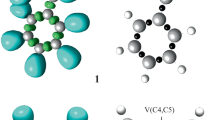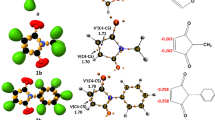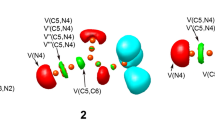Abstract
The [3+2] cycloaddition (32CA) reaction of N-methyl-C-(4-hydroxylphenyl) nitrone 1 and maleic anhydride 2 has been investigated using molecular electron density theory (MEDT) at the MPWB95/6-311++G(d,p) computational level. This 32CA reaction undergoes two stereo- and stereoisomeric reaction paths to form two different products 3 and 4. An electron localization function (ELF) study predicts that the N-methyl-C-(4-hydroxylphenyl) nitrone 1 has a zwitterionic character and it takes place through a one-step mechanism, with activation enthalpies in between 17.48 and 23.41 kJ mol−1 in the gas phase. The CDFT indices are used to forecast the global electron density flux from the strong nucleophilic N-methyl-C-(4-hydroxylphenyl) nitrone 1 to the electrophilic maleic anhydride 2. These exergonic 32CA reactions have negative Gibbs free energy along the endo and exo stereochemical routes. The endo stereochemical process is favored over the exo stereochemical pathway due to the increased thermodynamic stability of the cycloadduct. Bonding evolution theory (BET) predictions for the endo and exo routes indicate a one-step process with early transition states, which is consistent with the ELF topological investigation at the transition states.







Similar content being viewed by others
References
Huisgen R (1963) 1, 3-dipolar cycloadditions. past and future. Angew Chem Int Ed Engl 2(10):565–598
Curtius T (1883) Theodor Curtius: Ueber die. Ber Dtsch Chem Ges 16:2230–2231
Su YL et al (2021) Generation of diazomethyl radicals by hydrogen atom abstraction and their cycloaddition with alkenes. Angew Chem 133(34):18632–18636
Mohammad-Salim HA (2021) Understanding the reactivity of C-cyclopropyl-N-methylnitrone participating in [3+ 2] cycloaddition reactions towards styrene with a molecular electron density theory perspective. J Mex Chem Soc 65(1):129–140
Mohammad-Salim H et al (2020) theoretical study on the mechanism of [3+ 2] cycloaddition reactions between α, β-unsaturated selenoaldehyde with nitrone and with nitrile oxide. J Mex Chem Soc 64(2):147–164
Acharjee N, Mohammad-Salim HA, Chakraborty M (2022) Unveiling the synthesis of spirocyclic, tricyclic, and bicyclic triazolooxazines from intramolecular [3+ 2] azide-alkyne cycloadditions with a molecular electron density theory perspective. Struct Chem 33:1–16
Acharjee N, Mohammad-Salim HA, Chakraborty M (2021) Unveiling [3+ 2] cycloaddition reactions of benzonitrile oxide and diphenyl diazomethane to cyclopentene and norbornene: a molecular electron density theory perspective. Theor Chem Acc 140(8):1–15
Acharjee N, Mohammad-Salim HA, Chakraborty M (2021) Unveiling the regioselective synthesis of antiviral 5-isoxazol-5-yl-2ʹ deoxyuridines with a molecular electron density theory perspective. J Serb Chem Soc 00:106–106
Padwa A, Pearson WH (2003) Synthetic applications of 1, 3-dipolar cycloaddition chemistry toward heterocycles and natural products, vol 59. John Wiley & Sons, Hoboken, NJ
Eicher T, Hauptmann S, Speicher A (2013) The chemistry of heterocycles: structures, reactions, synthesis, and applications. John Wiley & Sons, Hoboken, NJ
Majumdar KC, Chattopadhyay SK (2011) Heterocycles in natural product synthesis. John Wiley & Sons, Hoboken, NJ
Lednicer D, Mitscher LA (1980) The organic chemistry of drug synthesis, volume 2, vol 1. John Wiley & Sons, Hoboken, NJ
Artemov A, Sazonova E, Zarovkina NY (2013) 1, 3-Dipolar cycloaddition reaction of nitrone η6-(arene) chromium tricarbonyl complexes with styrene and η6-(styrene) chromium tricarbonyl. Russ Chem Bull 62(6):1382–1387
Mohammad-Salim HA et al (2021) A molecular electron density theory study for [3+ 2] cycloaddition reactions of N-benzylcyclohexylnitrone with methyl-3-butenoate. New J Chem 45(1):262–267
Mohammad-Salim HA (2021) A molecular electron density theory study of the [3 + 2] cycloaddition reaction of nitronic ester with methyl acrylate. Theor Chem Acc 140(7):1–9
Krylov A et al (2018) Perspective: Computational chemistry software and its advancement as illustrated through three grand challenge cases for molecular science. J Chem Phys 149(18):180901
Domingo LR (2016) Molecular electron density theory: a modern view of reactivity in organic chemistry. Molecules 21(10):1319
Rıos-Gutiérrez M, Domingo L (2019) Unravelling the mysteries of the [3+ 2] cycloaddition reactions. Eur J Org Chem 2019(2–3):267–282
Ríos-Gutiérrez M et al (2017) A molecular electron density theory study of the [3+ 2] cycloaddition reaction of nitrones with ketenes. Org Biomol Chem 15(7):1618–1627
Domingo LR, Ríos-Gutiérrez M, Pérez P (2018) A molecular electron density theory study of the reactivity and selectivities in [3 + 2] cycloaddition reactions of C, N-dialkyl nitrones with ethylene derivatives. J Org Chem 83(4):2182–2197
Domingo LR, Ríos-Gutiérrez M, Pérez P (2019) Unveiling the high reactivity of cyclohexynes in [3 + 2] cycloaddition reactions through the molecular electron density theory. Org Biomol Chem 17(3):498–508
Domingo LR, Acharjee N (2020) Unravelling the strain-promoted [3+ 2] cycloaddition reactions of phenyl azide with cycloalkynes from the molecular electron density theory perspective. New J Chem 44(32):13633–13643
Domingo LR, Kula K, Ríos-Gutiérrez M (2020) Unveiling the reactivity of cyclic azomethine ylides in [3 + 2] cycloaddition reactions within the molecular electron density theory. Eur J Org Chem 2020(37):5938–5948
Domingo LR, Acharjee N (2020) Unveiling the high reactivity of strained dibenzocyclooctyne in [3+ 2] cycloaddition reactions with diazoalkanes through the molecular electron density theory. J Phys Org Chem 33(11):e4100
Domingo LR, Acharjee N (2020) A molecular electron density theory study of the Grignard reagent-mediated regioselective direct synthesis of 1, 5-disubstituted-1, 2, 3-triazoles. J Phys Org Chem 33(8):e4062
Domingo LR, Ríos-Gutiérrez M, Acharjee N (2019) A molecular electron density theory study of the chemoselectivity, regioselectivity, and diastereofacial selectivity in the synthesis of an anticancer spiroisoxazoline derived from α-santonin. Molecules 24(5):832
Abbiche K et al (2020) Insights into the mechanism and regiochemistry of the 1, 3-dipolar cycloaddition reaction between benzaldehyde and diazomethane. Theor Chem Acc 139(9):1–12
Becke AD, Edgecombe KE (1990) A simple measure of electron localization in atomic and molecular systems. J Chem Phys 92(9):5397–5403
Silvi B, Savin A (1994) Classification of chemical bonds based on topological analysis of electron localization functions. Nature 371(6499):683–686
Geerlings P, De Proft F, Langenaeker W (2003) Conceptual density functional theory. Chem Rev 103(5):1793–1874
Domingo LR, Ríos-Gutiérrez M, Pérez P (2016) Applications of the conceptual density functional theory indices to organic chemistry reactivity. Molecules 21(6):748
Sutcliffe BT (2006) The idea of a potential energy surface. Mol Phys 104(5–7):715–722
Domingo LR (2014) A new C–C bond formation model based on the quantum chemical topology of electron density. RSC Adv 4(61):32415–32428
Thom R (1974) “Stabilité Structurelle et Morphogenèse (Interéditions) 1972” THOM, R., Modèles Mathématiques de la Morphogenèse (Editions 10-18)
Krokidis X, Silvi B, Alikhani M (1998) Topological characterization of the isomerization mechanisms in XNO (X = H, Cl). Chem Phys Lett 292(1–2):35–45
Schlegel HB (1982) Optimization of equilibrium geometries and transition structures. J Comput Chem 3(2):214–218
Wiberg KB (1986) Ab initio molecular orbital theory by WJ Hehre, L. Radom, P. v. R. Schleyer, and JA Pople, John Wiley, New York, 548pp. Price: $79.95 (1986). Wiley Online Library, Hoboken, NJ
Acharjee N et al (2021) Unveiling the high regioselectivity and stereoselectivity within the synthesis of spirooxindolenitropyrrolidine: a molecular electron density theory perspective. J Phys Org Chem 34(6):e4189
Fukui K (1970) Formulation of the reaction coordinate. J Phys Chem 74(23):4161–4163
Gonzalez C, Schlegel HB (1990) Reaction path following in mass-weighted internal coordinates. J Phys Chem 94(14):5523–5527
Tomasi J, Persico M (1994) Molecular interactions in solution: an overview of methods based on continuous distributions of the solvent. Chem Rev 94(7):2027–2094
Simkin BI, Sheĭkhet II (1995) Quantum chemical and statistical theory of solutions: a computational approach. Ellis Horwood, Chichester
Cossi M et al (1996) Ab initio study of solvated molecules: a new implementation of the polarizable continuum model. Chem Phys Lett 255(4–6):327–335
Cances E, Mennucci B, Tomasi J (1997) A new integral equation formalism for the polarizable continuum model: theoretical background and applications to isotropic and anisotropic dielectrics. J Chem Phys 107(8):3032–3041
Barone V, Cossi M, Tomasi J (1998) Geometry optimization of molecular structures in solution by the polarizable continuum model. J Comput Chem 19(4):404–417
Lu T, Chen F (2012) Multiwfn: a multifunctional wavefunction analyzer. J Comput Chem 33(5):580–592
Pettersen EF et al (2004) UCSF Chimera—a visualization system for exploratory research and analysis. J Comput Chem 25(13):1605–1612
Frisch M et al (2016) Gaussian 16 revision a. 03. 2016. Gaussian Inc., Wallingford, CT
Reed AE, Weinstock RB, Weinhold F (1985) Natural population analysis. J Chem Phys 83(2):735–746
Reed AE, Curtiss LA, Weinhold F (1988) Intermolecular interactions from a natural bond orbital, donor–acceptor viewpoint. Chem Rev 88(6):899–926
Huisgen R (1976) 1, 3-Dipolar cycloadditions. 76. Concerted nature of 1, 3-dipolar cycloadditions and the question of diradical intermediates. J Org Chem 41(3):403–419
Parr RG, Yang W (1995) Density-functional theory of the electronic structure of molecules. Annu Rev Phys Chem 46(1):701–728
Domingo LR et al (2016) Understanding the carbenoid-type reactivity of nitrile ylides in [3 + 2] cycloaddition reactions towards electron-deficient ethylenes: a molecular electron density theory study. Theor Chem Acc 135(7):1–12
Domingo LR, Acharjee N (2018) [3+ 2] Cycloaddition reaction of C-phenyl-N-methyl nitrone to acyclic-olefin-bearing electron-donating substituent: a molecular electron density theory study. ChemistrySelect 3(28):8373–8380
Acharjee N, Banerji A (2020) A molecular electron density theory study to understand the interplay of theory and experiment in nitrone-enone cycloaddition. J Chem Sci 132(1):1–11
Domingo LR et al (2002) Quantitative characterization of the global electrophilicity power of common diene/dienophile pairs in Diels-Alder reactions. Tetrahedron 58(22):4417–4423
Jaramillo P et al (2008) A further exploration of a nucleophilicity index based on the gas-phase ionization potentials. J Mol Struct (Thoechem) 865(1–3):68–72
Parr RG, Weitao Y (1994) Aspects of atoms and molecules. In: Parr RG, Weitao Y (eds) Density-functional theory of atoms and molecules. Oxford University Press, Oxford
Parr RG, Pearson RG (1983) Absolute hardness: companion parameter to absolute electronegativity. J Am Chem Soc 105(26):7512–7516
Parr R, Szentpaly L, Liu S (1999) Electrophilicity index. J Am Chem Soc 121:1922
Domingo LR, Chamorro E, Pérez P (2008) Understanding the reactivity of captodative ethylenes in polar cycloaddition reactions. A theoretical study. J Org Chem 73(12):4615–4624
Lee Y-S, Park SM, Kim BH (2009) Synthesis of 5-isoxazol-5-yl-2′-deoxyuridines exhibiting antiviral activity against HSV and several RNA viruses. Bioorg Med Chem Lett 19(4):1126–1128
Domingo LR, Ríos-Gutiérrez M, Pérez P (2020) Unveiling the Lewis acid catalyzed Diels-Alder reactions through the molecular electron density theory. Molecules 25(11):2535
Author information
Authors and Affiliations
Corresponding author
Ethics declarations
Conflict of interest
The authors declare no conflict of interest.
Additional information
Publisher's Note
Springer Nature remains neutral with regard to jurisdictional claims in published maps and institutional affiliations.
Rights and permissions
About this article
Cite this article
Mohammed Salih, S.A., Basheer, H.A. & Mohammad-Salim, H.A. Insights into the mechanism and stereoselectivity of the [3+2] cycloaddition reaction between N-methyl-C-(4-hydroxylphenyl) nitrone and maleic anhydride with a molecular electron density theory perspective. Theor Chem Acc 141, 33 (2022). https://doi.org/10.1007/s00214-022-02891-9
Received:
Accepted:
Published:
DOI: https://doi.org/10.1007/s00214-022-02891-9




